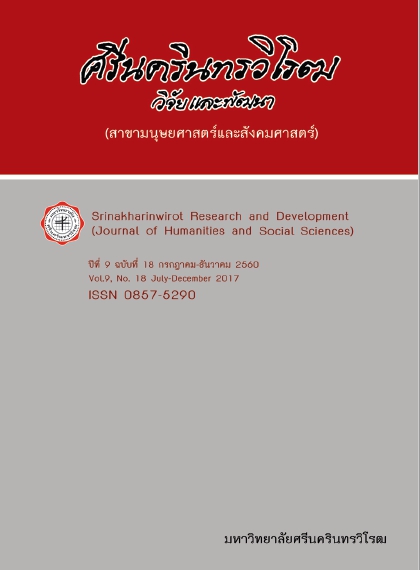ความเปราะบางต่อภัยธรรมชาติของครัวเรือน: กรณีศึกษาจากเหตุการณ์น้ำท่วมปี พ.ศ. 2554 ในประเทศไทย (VULNERABILITY TO DISASTER OD HOUSEHOLD: THE CASE STUDY FROM THE 2011 FLOOD IN THAILAND)
Abstract
ปัจจุบัน โลกของเราได้ประสบปัญหาสิ่งแวดล้อมมากมาย โดยมีสาเหตุหลักมาจากการกระทำของมนุษย์
ภัยธรรมชาติต่างๆ มีแนวโน้มที่จะเกิดบ่อยครั้งและรุนแรงมากยิ่งขึ้น ตัวอย่างหนึ่งของภัยธรรมชาติที่เกิดขึ้นในประเทศไทย คือ มหาอุทกภัยปี พ.ศ. 2554 ซึ่งผลกระทบเป็นวงกว้าง และก่อความสูญเสียให้กับระบบเศรษฐกิจทั้งในระยะสั้นและระยะยาว การศึกษาความเปราะบางต่อภัยธรรมชาติของครัวเรือน จึงเป็นการมองผลกระทบจากภัยธรรมชาติหรือสิ่งที่เกิดขึ้นโดยไม่คาดคิดในอีกมิติหนึ่ง อันจะนำไปสู่การหามาตรการป้องกัน หรือนโยบายในการลดความรุนแรงและช่วยเหลือผู้เปราะบางได้ โดยการศึกษานี้มีวัตถุประสงค์เพื่อศึกษาปัจจัยที่กำหนดความเปราะบางต่อภัยธรรมชาติของครัวเรือน และผลกระทบทางเศรษฐกิจจากปัญหาน้ำท่วม ปี พ.ศ. 2554 โดยใช้ข้อมูลจากการสำรวจครัวเรือนที่ประสบภัยในพื้นที่น้ำท่วมช่วงเดือนกรกฎาคม-ธันวาคม 2554 ของสำนักงานสถิติแห่งชาติ และใช้วิธีการวิเคราะห์ปัจจัย (Principle Component Analysis) ในการวิเคราะห์ความเปราะบางต่อภัยธรรมชาติ การวิเคราะห์ปัจจัยในการศึกษานี้ จะได้ค่าดัชนีสามค่าที่เกี่ยวข้องกับความเปราะบางต่อภัยธรรมชาติ คือ ดัชนีโอกาสเสี่ยงภัย ดัชนีความอ่อนไหว และดัชนีความสามารถในการกลับสู่สภาพเดิม โดยดัชนีความสามารถในกลับสู่สภาพเดิมของครัวเรือนจะส่งผลต่อความสูญเสียทางเศรษฐกิจของครัวเรือนสูงกว่าดัชนีอื่น ถ้าหากพิจารณาเฉพาะจังหวัดที่อยู่บริเวณลุ่มแม่น้ำเจ้าพระยา ที่ประสบกับภาวะน้ำท่วมในปี พ.ศ. 2554 อย่างรุนแรง พบว่า ดัชนีความอ่อนไหวและความสามารถในการกลับสู่สภาพเดิมจะส่งผลต่อความสูญเสียทางเศรษฐกิจ และการสูญเสียรายได้ของครัวเรือนในกลุ่มนี้ มากกว่ากรณีกลุ่มตัวอย่างรวม ทั้งนี้ การจัดทำแผนจัดการน้ำท่วมและแผนบรรเทาทุกข์ รวมถึงการคาดการณ์สถานการณ์น้ำท่วม และการเตือนภัยอย่างมีประสิทธิภาพของภาครัฐ จึงมีความสำคัญต่อการป้องกันความเปราะบางต่อภัยธรรมชาติของครัวเรือน และช่วยลดความสูญเสียทางเศรษฐกิจของครัวเรือนได้
Nowadays, our world is facing many environmental issues which mainly due to human activities. Natural disasters are prone to frequent and more intense. The previous example of a natural disaster that occurred in Thailand is the 2011 flood which affected in wide area especially the economy loss, both in the short and long term. Vulnerability to disaster is the one dimension of studying about effected of unexpected shock. This will lead policy maker to find some preventive measures and policy to reduce the severity and fragile of households. The aim of this study was analysis the determinants of vulnerability to disaster and economic impact from the 2011 flood to household by using the data from survey of the 2011 flood on the livelihood of Thai households during July to December 2011 by National Statistic Office. Principle Component Analysis was the Methodological approach to analyze household vulnerability to disaster which employed three indeices: expose index, susceptibility index and resilience index. The result showed that the resilience index was the greater effect on the loss of households than the others do. For the provinces located in Chaopraya river area which suffered from the 2011 flood, the affect from susceptibility index and resilience index to their economic loss and income loss were more than the total of household samples. In addition, the flood management and relief plan, flood forecasting and efficiency warning from the public sector were the vital for the protection of household vulnerability to disasters and reduce the household loss.
Downloads
References
/AnalysisBLP/1ThaiFloodSurvey2011.pdf
[2] Cannon, Terry (Ed.). (1994). Vulnerability Analysis and the Explanation of 'Natural, Disasters (Ann Varley ed.).
[3] Messner, Frank, & Meyer, Volker. (2005). Flood damage, vulnerability and risk perception -challenges for flood damage research. UFZ Discussion Papers, 13/2005. Retrieved Aug 15, 2012, from
http://www.ufz.de/export/data/1/26222_Disk_Papiere_2005_13.pdf
[4] León, J. C. V. D. (2006). Vulnerability: A Conceptual and Methodological Review. Germany: Paffenholz, Bornheim.
[5] UNESCO-THE Institute for Ware Education. Retrieved December 26, 2012, from http://www.unesco-ihe-fvi.org/
[6] Brooks, Nick. (2003). Vulnerability, risk and adaptation: A conceptual framework. Tyndall Centre for Climate Change Research Working Paper 38, from http://www.tyndall.ac.uk/sites/default/
files/wp38.pdf
[7] Alwang, Jeffrey, Siegel, Paul B., & Jørgensen, Steen L. (2001). Vulnerability: A View From Different Disciplines. Social Protection Discussion Paper Series. Retrieved December 23, 2012, from http://siteresources.worldbank.org/SOCIALPROTECTION/Resources/SP-Discussion-papers/Social-Risk-Management-DP/0115.pdf
http://www.tandfonline.com/doi/abs/10.1080/01436597.2013.755356
[8] Schilderinck, Gerard. (2009). Drought Cycle Management in arid and semi-arid Kenya: Arelevant disaster risk reduction model. Catholic Organisation for Relief and Development Aid. Retrieved April 8, 2012, from http://www.google.co.th/url?sa=t&rct=j&q=&esrc=s&frm=1&source=web&cd=1&ved=
0CCwQFjAA&url=http%3A%2F%2Fwww.alnap.org%2Fpool%2Ffiles%2F100-10035b-final-drr-research-report.pdf&ei=FLlbUqyfJIaMrQeH7ICQAw&usg=AFQjCNEkRLYw6pudXYqb
4P02GUgTIa1ciw&bvm=bv.53899372,d.bmk
[9] Kang, Sung Jin, & Sawada, Yasuyuki. (2002). Household Coping Strategies and the Financial Crisis in Korea. University of Tsukuba, University of Tokyo. Retrieved Aug 15, 2012,
from http://www.karyiuwong.com/confer/seoul02/papers/sawada.pdf
[10] Patnaik, Unmesh, & Narayanan, K. (2010). Vulnerability and Coping to Disasters: A study of Household Behavior in Flood Prone Region of India. Munich Personal RePEc Archive. Retrieved Sep 19, 2012,
from http://mpra.ub.uni-muenchen.de/21992/
[11] Skoufias, Emmanuel. (2003). Economic Crises and Natural Disaster: Coping Strategies and Policy Implications. World Development. 31(7): 1087-1102. Retrieved February 12, 2013, from
http://info.worldbank.org/etools/docs/library/78330/3rd%20Workshop/Srmafrica/paristwo/pdf/readings/weather.pdf
[12] Okuyama, Y. (2008). Critical review of methodologies on disaster impact estimation. Background paper for EDRR report. Retrieved from https://gfdrr.org/sites/gfdrr.org/files/New%20Folder/Okuyama
_Critical_Review.pdf
[13] Coburn, A. W., Sspence, R. J. S., & Pomonis, A. (1994). Vulnerability and risk assessment. Disaster Management Training Programme. Retrieved from http://worldbank.mrooms.net/file.php/356/
2234/Introduction%20Reading%20-%20VulnerabilityAndRiskAssessmentGuide.pdf
[14] สุชาติ ประสิทธิ์รัฐสินธุ์; และ กรรณิการ์ สุขเกษม. (2533). เทคนิคทางสถิติชั้นสูงสำหรับการวิเคราะห์ข้อมูลด้วยไมโครคอมพิวเตอร์ และโปรแกรมสำเร็จรูป SPPSS PC+ เล่ม 1 การวิเคราะห์ปัจจัย และการวิเคราะห์จัดกลุ่ม. กรุงเทพฯ: โรงพิมพ์ภาพพิมพ์.
[15] Cutter, S. L., Boruff, B. J., & Shirley, W. L. (2003). Social vulnerability to environmental hazards. Social Science Quarterly, 84(2), 242-261. Retrieved from http://www.colorado.edu/hazards/resources/
socy4037/Cutter%20%20%20Social%20vulnerability%20to%20environmental%20hazards.pdf
[16] Fekete, A. (2009). Validation of a social vulnerability index in context to river-floods in Germany. Natural Hazards and Earth System Sciences. 9(2): 393-403. Retrieved from http://www.nat-hazards-earth
-syst-sci.net/9/393/2009/nhess-9-393-2009.pdf
[17] Willroth, P., Diez, J. R., & Arunotai, N. (2011). Modelling the economic vulnerability of households in the Phang-Nga Province (Thailand) to natural disasters. Natural hazards. 58(2): 753-769. Retrieved from
http://link.springer.com/article/10.1007/s11069-010-9635-1
[18] กัลยา วานิชย์บัญชา. (2544). การวิเคราะห์ตัวแปรหลายตัวด้วย SPSS for Windows. ภาควิชาสถิติ
คณะพาณิชยศาสตร์และการบัญชี จุฬาลงกรณ์มหาวิทยาลัย.
[19] กัลยา วานิชย์บัญชา. (2548). สถิติสำหรับงานวิจัย. ภาควิชาสถิติ คณะพาณิชยศาสตร์และการบัญชี จุฬาลงกรณ์มหาวิทยาลัย.
[20] Ninno, Carlo del, Dorosh, Paul A., Smith, Lisa C., & Roy, Dilip K. (2001). The 1998 Floods in Bangladesh: Disaster Impacts, Household Coping Strategies, and Response. Washington, D.C.: International Food Policy Research Institute. Retrieved May 17, 2012, from
http://www.ifpri.org/sites/default/files/publications/rr122.pdf
[21] พรเทพ เบญญาอภิกุล. (2555). การประเมินความเสียหายเบื้องต้นของภาคอุตสาหกรรมจากเหตุการณ์มหาอุทกภัย 2554 ด้วยระบบข้อมูลภูมิสารสนเทศและสำมะโนอุตสาหกรรม. ใน ภราดร ปรีดาศักดิ์ และ สิทธิกร นิพภยะ (บรรณาธิการ), Symposium 35 เหลียวหลังแลหน้า มหาอุทกภัย 2554 (น. 37-69). กรุงเทพฯ: หจก. สามลดา.
Downloads
Published
How to Cite
Issue
Section
License
Srinakharinwirot Research and Development Journal of Humanities and Social Sciences is licensed Under a Creative Commons Attribution-NonCommercial-NoDerivs 4.0 International (CC-BY-NC-ND 4.0) License, Unless Otherwise Stated. Please Read Journal Policies Page for More Information on Open Access, Copyright and Permissions.


